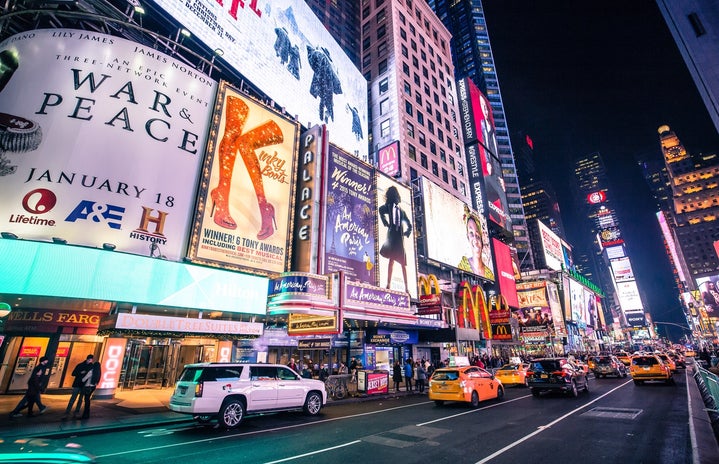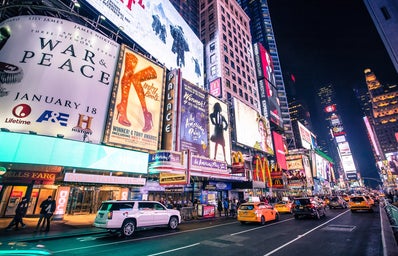In the glittering world of New York’s streets, where creativity takes center stage, a curious trend has emerged: the proliferation of musicals adapted from beloved movies.
Walking down Sixth Avenue in the last few years you could easily be faced with a thirty-feet tall hot pink sign advertising Mean Girls, another billboard for Frozen, and yet another set of flashing lights advertising Pretty Woman, to name a few. It’s a phenomenon that has raised eyebrows amongst theater purists and sparked heated debates within the industry. So, what’s the deal with this surge in Broadway musicals based on movies? Let’s address the elephant in the room.
THE BEGINNING
The fact is musical theater has long embraced the art of adaptation. For instance, in 1927, Show Boat brought Edna Ferber’s novel to life on stage while Oklahoma drew its inspiration from Lynn Riggs’s play Green Grow The Lilacs. Musicals have found their inspiration material in a lot of different sources including novels (Les Miserables and The Phantom of the Opera), plays, short stories (South Pacific), comics (Annie and You’re A Good Man, Charlie Brown), and even in the Bible (Godspell).
As the allure of cinema grew, musicals increasingly found inspiration in the world of movies. Starting with Silk Stockings (1955) based on the Melchior Lengyel story Ninotchka and the 1939 film adaptation, this trend encompassed a diverse range of films, from arthouse masterpieces like Fellini’s 8 ½ (adapted to Broadway as Nine by Maury Yeston) to Ingmar Bergman’s Smiles of A Summer Night that inspired Stephen Sondheim for A Little Night Music, to blockbusters like Moulin Rouge.
While some musicals aim to merely replicate the movie experience, others choose to draw inspiration from films in a more subtle and creative manner. The former as Moulin Rouge, faithfully reproduces its inspiration – the musical movie. On the other hand, musicals that are merely inspired by films, as Beetlejuice, use key elements of cinematic narrative as a starting point but develop their own approach, exploring new angles, deepening characters, adding songs and offering a unique interpretation of the story, challenging audience expectations, and enriching the cultural landscape.
CREATIVITY X COMMERCIALISM
Some critics argue that the surge of movie-based musicals reflects a lack of originality and risk-taking in the theater industry. Instead of nurturing new, groundbreaking works, Broadway seems increasingly reliant on the built-in audience appeal of well-known film properties. This reliance on existing intellectual property can stifle innovation, leaving theater enthusiasts craving fresh narratives and original scores.
However, it would be remiss to overlook the financial incentives driving this trend. Producing a Broadway musical is a high-cost endeavor, with budgets often stretching into the millions. In such a high-stakes environment, producers are understandably drawn to projects with built-in brand recognition.
The adaptation of popular movies for the stage became increasingly prevalent in the 21st century and might be linked to the surge in social media and our love for instant gratification. In a world where you can get any book or movie with a touch on a screen, where chatting face-to-face is now just an app away, and where you have all the world’s knowledge, music, and fun right on your phone, it’s getting tougher to convince folks to leave their cozy homes and spend big bucks to catch live theater shows. The result? Musicals premiering on Broadway are closing much earlier than usual, unable to sustain themselves in the competitive market.
Broadway is trying to keep up with these changes by using screens and cool visuals on stage, running active social media ads, and putting cast albums up for streaming. But even with all that, it’s still not easy to get people to show up and keep funding these big-budget productions.
While Broadway attracts a specific group of fans – only a limited number of people truly appreciate the talent and hard work involved in two hours of actors singing and dancing in extravagant outfits on stage – the reality is that Broadway’s accessibility remains a significant issue for a large portion of the population. The high cost of tickets, combined with the expense of traveling to New York City, makes attending a Broadway show prohibitive for many individuals. Moreover, this accessibility challenge is exacerbated by the internet age. While the internet has brought Broadway shows closer to audiences around the world through promotional materials, live streams, and social media, it has also created a paradoxical situation. Despite the growing global fan base for Broadway, a significant portion of these fans will never have the opportunity to experience a live performance due to geographical and financial constraints. This disconnect between admiration and accessibility underscores the need for Broadway and the theater industry as a whole to explore innovative solutions to make live theater more inclusive and accessible to a wider audience.
Movies, on the other hand, appeal to almost everyone and gain worldwide recognition because they aren’t limited to theater halls. By capitalizing on the popularity and success of these beloved stories, along with the recognition they bring, Broadway can draw in an audience that wouldn’t typically be interested in spending their money buying musical´s tickets. Leveraging the familiarity of successful films attracts those who grew up watching them – mainly New York’s population – who usually don’t get interested in what’s in theaters and become curious to see how their favorite movies translate to a different medium.
This mirrors the motivation behind the wave of movies adapted from dystopian young adult fiction: if the book has readers, the movie will attract viewers, even if it’s just to see how the filmmakers interpret the story. This crossover appeal can help sustain the vitality of Broadway and ensure its continued relevance in an ever-evolving entertainment landscape.
Interestingly, this creative process can also be reversed, as demonstrated by movie musicals like Cats, originally conceived for the stage. The cycle comes full circle when a production like the most recent Wicked transitions from novel to stage and is then reimagined as a cinematic musical, with great names as Ariana Grande playing Glinda and Cynthia Erivo as Elphaba coming to theaters later this fall.
HOW TO KEEP ORIGINALITY?
One of the major draws of Broadway is the creativity and effort that goes into every stage of producing a show; from writing, to set, to costume, to lights, everything takes thought and effort to make it look as seamless and magical as it does once it hits the stage. But let’s not dismiss movie-based musicals outright. When executed thoughtfully, these adaptations can breathe new life into familiar stories, offering audiences a fresh perspective through the lens of song and dance. Take, for example, The Lion King which seamlessly translated the beloved animated film to the stage, captivating audiences with its stunning visuals and inventive puppetry, and still does after 25 years live at Minskoff Theatre.
The most straightforward adaptation approach is to use songs from random artists and place them at points in the story as Mamma Mia (Abba songs) and Rock of Ages (songs from multiple Rock famous artists) to create a jukebox-style experience. Other adaptations, such as School of Rock and Pretty Woman take an existing plot and insert original songs, usually by one composer. Disney’s stage adaptations tend to be a hybrid of these two approaches, incorporating the well-loved songs from the movie and adding new songs by the same composer, a great example of this is The Little Mermaid that have several new musical numbers as “Human Stuff”, “She’s in Love” and “Her Voice” written just for the stage adaptation.
Songs are used to create memorable production numbers, but also take the place of dialogue or provide a reflective solo number. Some of the most successful film adaptations, such as Beetlejuice, bring new elements to create a stage version with enough familiarity to appeal to the audience while also updating the setting or altering the plot to spark new moments of engagement.
That being said, it’s crucial to strike a balance between honoring theatrical tradition and embracing innovation. While movie-inspired musicals have their place in the Broadway ecosystem adding that three-dimensional brilliance to the two-dimensions of a movie, they do not strip away the wonder of theater and original storytelling. It’s essential to recognize that Broadway isn’t solely reliant on adaptations. Modern original musicals like Hamilton, Six, The Book of Mormon and others have proven to be massive successes, captivating audiences with their fresh narratives, innovative music, contemporary but historical themes and solding out many of their live performances. These productions demonstrate that the theater thrives on diversity and experimentation, showcasing the limitless possibilities of live performance. As Broadway continues to evolve, it’s essential to preserve that spirit of creativity for future generations.
So, why are there so many musicals based on movies on Broadway? The answer is complex, encompassing financial considerations, audience demand, and the eternal quest for artistic expression. While opinions may vary on the merits of this trend, one thing is certain: as long as there are stories to be told and songs to be sung, Broadway will continue to evolve, adapting to the changing tastes of audiences while staying true to its enduring spirit.
———————————————————
The article above was edited by Fernanda Miki Tsukase.
Like this type of content? Check out Her Campus Casper Libero for more.


